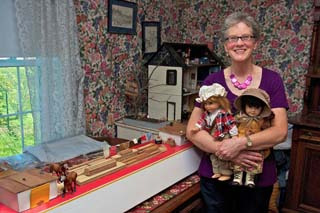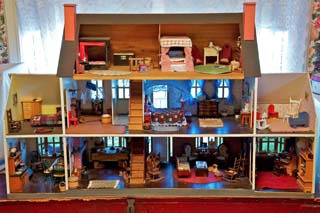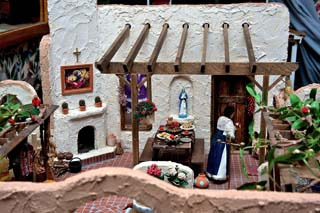Dollhouse programs bring history to life
by Terra Osterling
 Teresa Wood of History Houses, in her dining room-turned-dollhouse workshop, with dolls Kate and Skeeter and the 1830 canal cargo boat Fire Fly built by husband Charlie. Kit Kittredge’s 1934 boarding house is over her shoulder. Photograph by David Knox.Churchville resident Teresa Wood had a terrible headache. She and grown daughter Madeline were out for a drive, but the recurring migraines that had sidelined her from teaching some years earlier when son Charles was a toddler crept in that afternoon. As Madeline drove toward home, she glimpsed a dollhouse by the side of the road with a sign reading “Free.”
Teresa Wood of History Houses, in her dining room-turned-dollhouse workshop, with dolls Kate and Skeeter and the 1830 canal cargo boat Fire Fly built by husband Charlie. Kit Kittredge’s 1934 boarding house is over her shoulder. Photograph by David Knox.Churchville resident Teresa Wood had a terrible headache. She and grown daughter Madeline were out for a drive, but the recurring migraines that had sidelined her from teaching some years earlier when son Charles was a toddler crept in that afternoon. As Madeline drove toward home, she glimpsed a dollhouse by the side of the road with a sign reading “Free.”
“I had always wanted a dollhouse, always,” recalls Teresa, and Madeline pulled over to rescue the ten-room Colonial providentially placed in their path.
Seven years later, Teresa Wood is the master-storyteller behind History Houses, an American Girl Doll-inspired traveling history, dollhouse and story program that has toured to over 40 libraries, senior centers, scout troops, and other community organizations throughout western New York, the Finger Lakes and as far as the Saratoga Springs area.
 This 1774 Colonial, Teresa Wood’s roadside find, is home to American Girl Doll Felicity and the setting of a story of patriotism, friendship and America on the brink of revolution. Photograph by David Knox.Each of Teresa’s 10 houses, plus a canal cargo boat, represent time periods in American history ranging from 1774 to 1974. A map, three ordinary antique or modern objects together with girl and boy American Girl-styled dolls are the props for a 45 minute history-steeped story that always ends with a moral.
This 1774 Colonial, Teresa Wood’s roadside find, is home to American Girl Doll Felicity and the setting of a story of patriotism, friendship and America on the brink of revolution. Photograph by David Knox.Each of Teresa’s 10 houses, plus a canal cargo boat, represent time periods in American history ranging from 1774 to 1974. A map, three ordinary antique or modern objects together with girl and boy American Girl-styled dolls are the props for a 45 minute history-steeped story that always ends with a moral.
“From my experience, our history has been distorted and I want to make sure that kids know what really happened,” Wood says as she reflects on how one dollhouse became her journey back to teaching, which she had so loved and missed.
Wood’s dollhouses started out as an interior-decorating-in-miniature hobby. Later, several young girls from church approached her to help restore their dollhouses. She then used her expanding collection of dollhouses to present a program for her church’s mother-daughter banquet. That grew into visiting local libraries for singing, guitar music courtesy of husband Charlie, and play-time with the dollhouse pieces to educate little ones on topics such as bath time and manners.
Then in 2009, the Swan Library in Albion called asking whether she could present on five historic time periods for their American Girl Doll club.
“I thought, ‘I’ve got five houses’, so I said yes!” Wood had continually acquired dollhouses, décor and furniture and went straight to work re-decorating for time periods, herself crafting pieces when the need arose, and researching the history – all along mining for curriculum. She also collected more American Girl dolls, many from Craigslist, clipping the hair on some to style boy dolls. The Swan Library program “went over incredibly well,” says Wood with a smile, adding, “This is where it gets fun.”
A phone call to the American Girl Doll Company, the online and catalog retailers of the historical character dolls and story books, reassured Wood that her history-focused programs would not be a conflict for their business.
Encouraged, she proposed an idea to Donna Haire, director of the Newman Riga Public Library just down the road from Wood’s home: Would Newman Riga Library serve as her test site for a seven-week series of programs, one historic dollhouse and story per week, beginning with America on the brink of Revolution in 1774?
 The courtyard of Josefina Montoya’s 1824 adobe rancho is intricately decorated by Teresa Wood of Churchville. Josefina meets an “Americano” in this New Mexico Territory story and history lesson. Photograph by David Knox.Haire agreed, thereby creating both a deadline and accountability for Wood’s fledgling curriculum. The audience increased each week. Children, girls and boys, their parents and grandparents began to fill the Newman Riga Library for the programs.
The courtyard of Josefina Montoya’s 1824 adobe rancho is intricately decorated by Teresa Wood of Churchville. Josefina meets an “Americano” in this New Mexico Territory story and history lesson. Photograph by David Knox.Haire agreed, thereby creating both a deadline and accountability for Wood’s fledgling curriculum. The audience increased each week. Children, girls and boys, their parents and grandparents began to fill the Newman Riga Library for the programs.
“Her strength is her ability to teach a history lesson,” says Haire, noting that Wood “hooks them with the house and dolls, (and) before you know it the adults are moving forward” to get a closer look and hear the stories.
A story program centered on American Girl Doll Kit Kittredge’s 1934 Depression-era boarding house includes as props a “bank closed” sign, work boots and “rickrack,” the zig-zag ribbon fabric which, in Wood’s story, is used to prettily refinish the fraying hem of a well-worn dress. This story program is especially appealing to grandparents who eagerly raise their hand when Wood asks if anyone remembers the “rag man” or ever wore a “feed sack dress.”
“They love it; it jogs their memories,” Wood says about the audiences at senior centers, where the Depression-era story program is popular.
Wood has also built stories around a Nez Perce tipi, southwestern adobe rancho, frontier cabin, slave shack, Victorian mansion, New York City row house, and a California apartment building. Her most recent story program centers on a locally relevant topic: Life on the Erie Canal.
 The attic bedroom of all-American girl and aspiring journalist Kit Kittredge. Kit’s Great Depression story appeals to children ages 8 to 80 years young. Photograph by David Knox.Approached by the Town of Perinton to create a program for their Bicentennial this year, Wood studied the town’s history and hit on the idea of an Erie Canal-themed story. She thought, what better way to tell a story about the Erie Canal than to build it around a canal boat.
The attic bedroom of all-American girl and aspiring journalist Kit Kittredge. Kit’s Great Depression story appeals to children ages 8 to 80 years young. Photograph by David Knox.Approached by the Town of Perinton to create a program for their Bicentennial this year, Wood studied the town’s history and hit on the idea of an Erie Canal-themed story. She thought, what better way to tell a story about the Erie Canal than to build it around a canal boat.
Charlie Wood, Teresa’s husband, volunteered to construct the boat when it became clear that to find a model canal boat to match the quality of Teresa’s houses would be a high-priced venture.
“I said to Teresa, ‘I will build you a boat’ – even though I’m not a model maker or a boat guy,” Charlie recalls. He researched photos, sketches and diagrams to scale down a 60 foot canal boat while Teresa set to work on her first program which was not based on an American Girl set of story books.
Once again, providence intervened as Charlie sorted through three generations worth of findings in their barn and came across an odd, long wooden box which, when cut down to five feet, became the perfect hull of the 1:12 scale canal cargo boat christened Fire Fly.
Meanwhile, Teresa read through Erie Canal histories and youth fiction. “Ghost stories told, fear of thunderstorms, fire in the stove, ducking for bridges and lessons learned – I just brought them all together with new characters and chose 1830. ‘My story’ is based on all of their stories,” Teresa says, about how she developed her story program about cousins Kate and Skeeter bonding while traveling on the Erie Canal to visit their grandmother.
Charlie Wood’s work on the Fire Fly was a labor of love, and he felt that “boys might really be interested in this,” the canal boat, which he says will float – not that Teresa would ever permit it!
History Houses, especially the Fire Fly, has been a family affair for the Woods. They read and research together and fifteen-year-old son Charles is Wood’s skilled photographer and webmaster. “We’ve learned history together,” says Teresa, noting husband Charlie’s special connection to the Erie Canal cargo boat project – as a boy, great-grandfather George Wood worked as a hoggee, a mule-driver pulling canal boats in the Lockport area.
While she hasn’t seen it yet, Newman Riga Library’s Donna Haire anticipates another “amazing program” in Wood’s new Erie Canal-themed “History Houses” story, saying, “We have lots of programs, but you have a couple that come along that really ‘wow’.”
“Kate and Skeeter in Glory Days on the Erie Canal – 1830” debuts at 7 p.m., June 19 at the Newman Riga Library in Churchville, and at the Ogden Farmers’ Library on August 14 and Brockport Seymour Library on August 15.
Note: For information on upcoming History Houses programs, visit http://historyhouses.webs.com/ .



